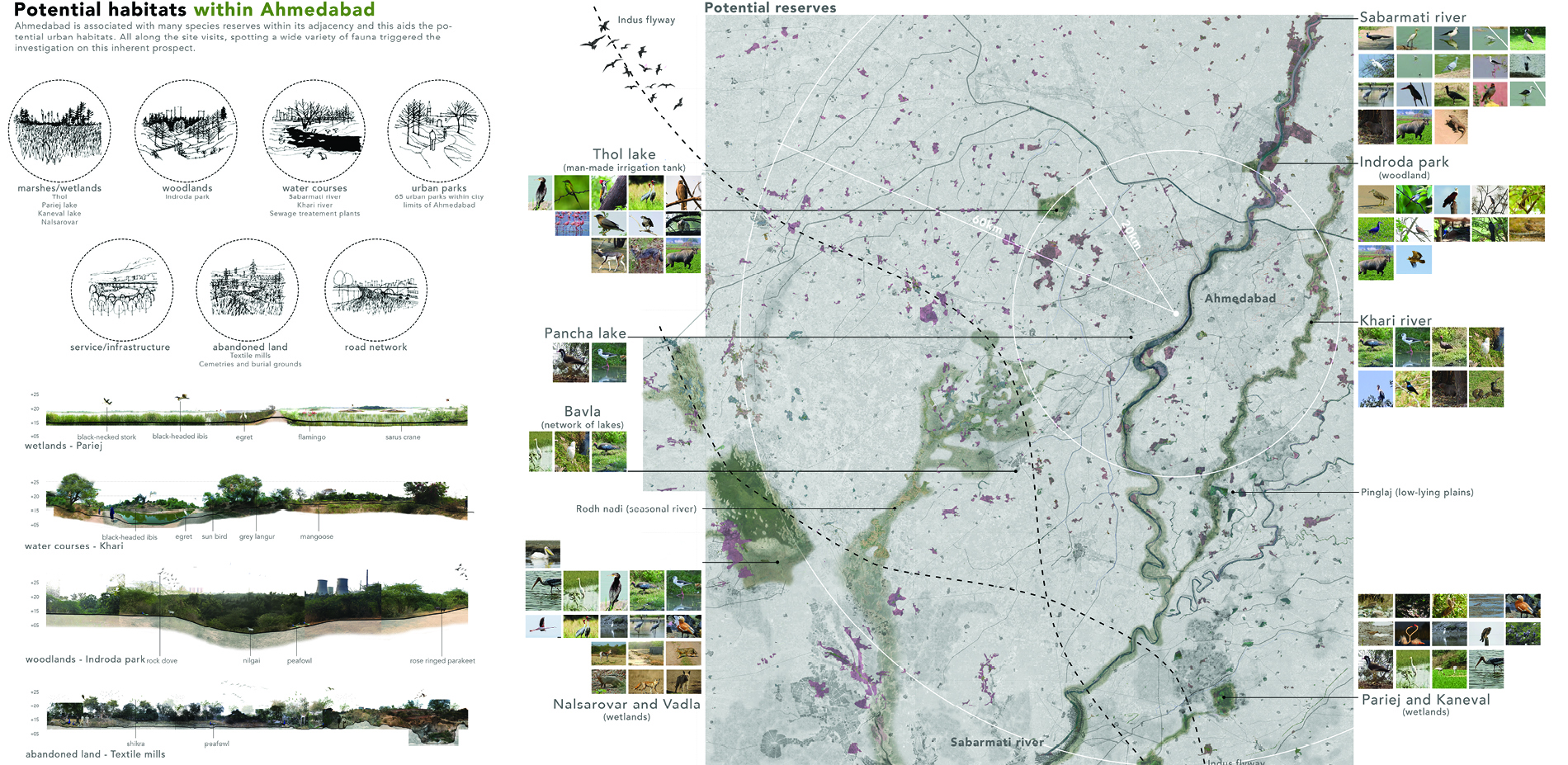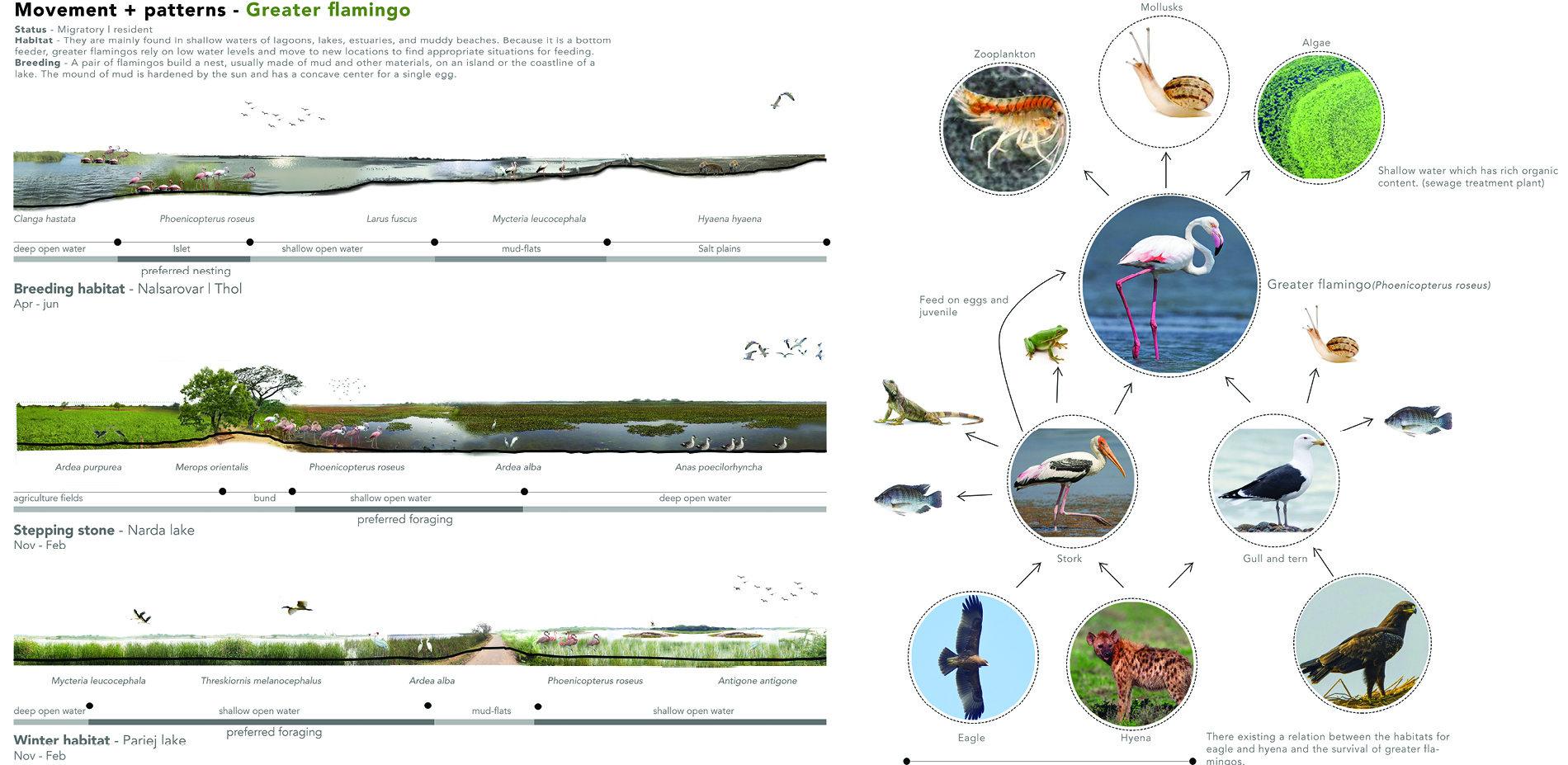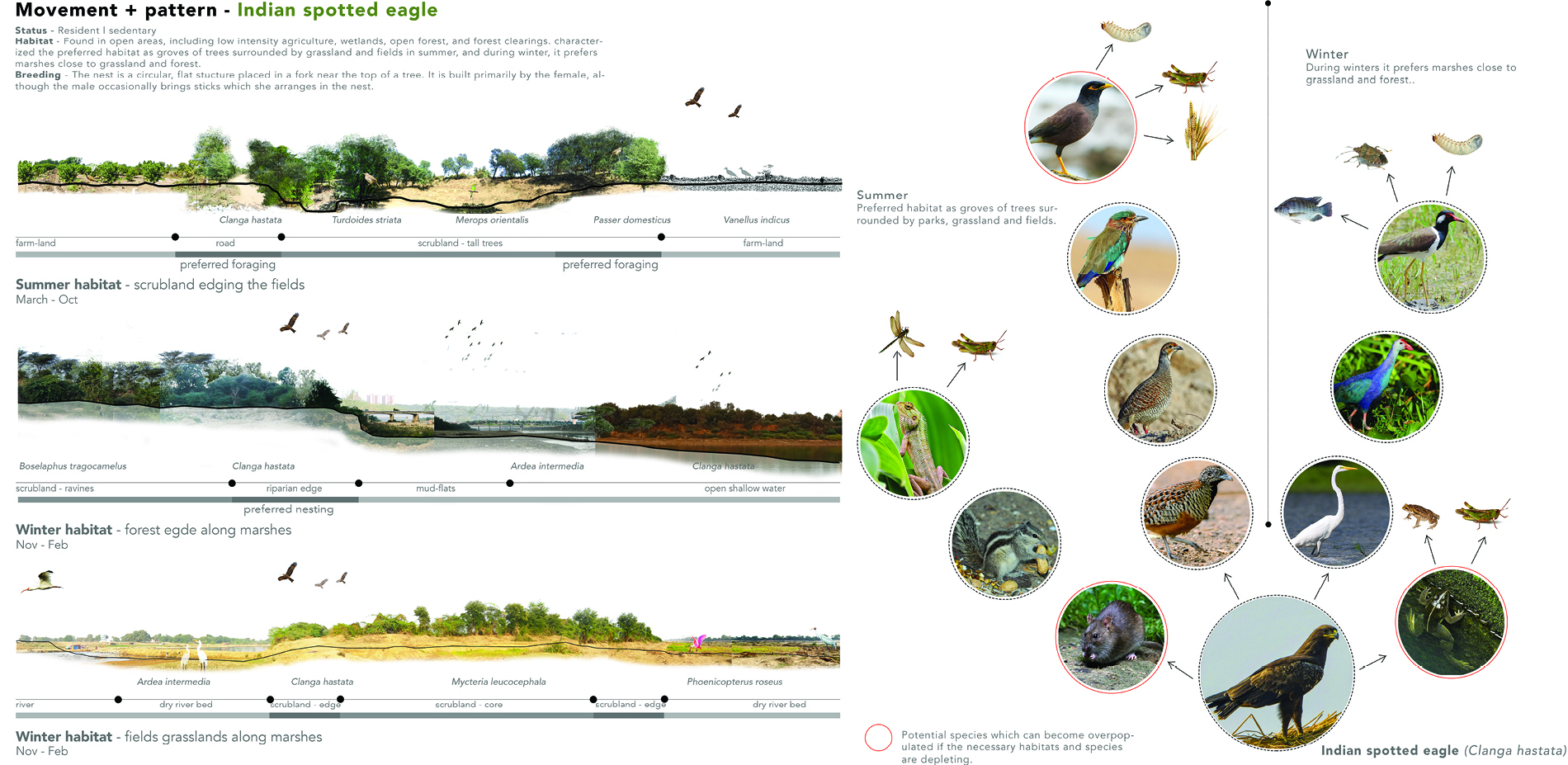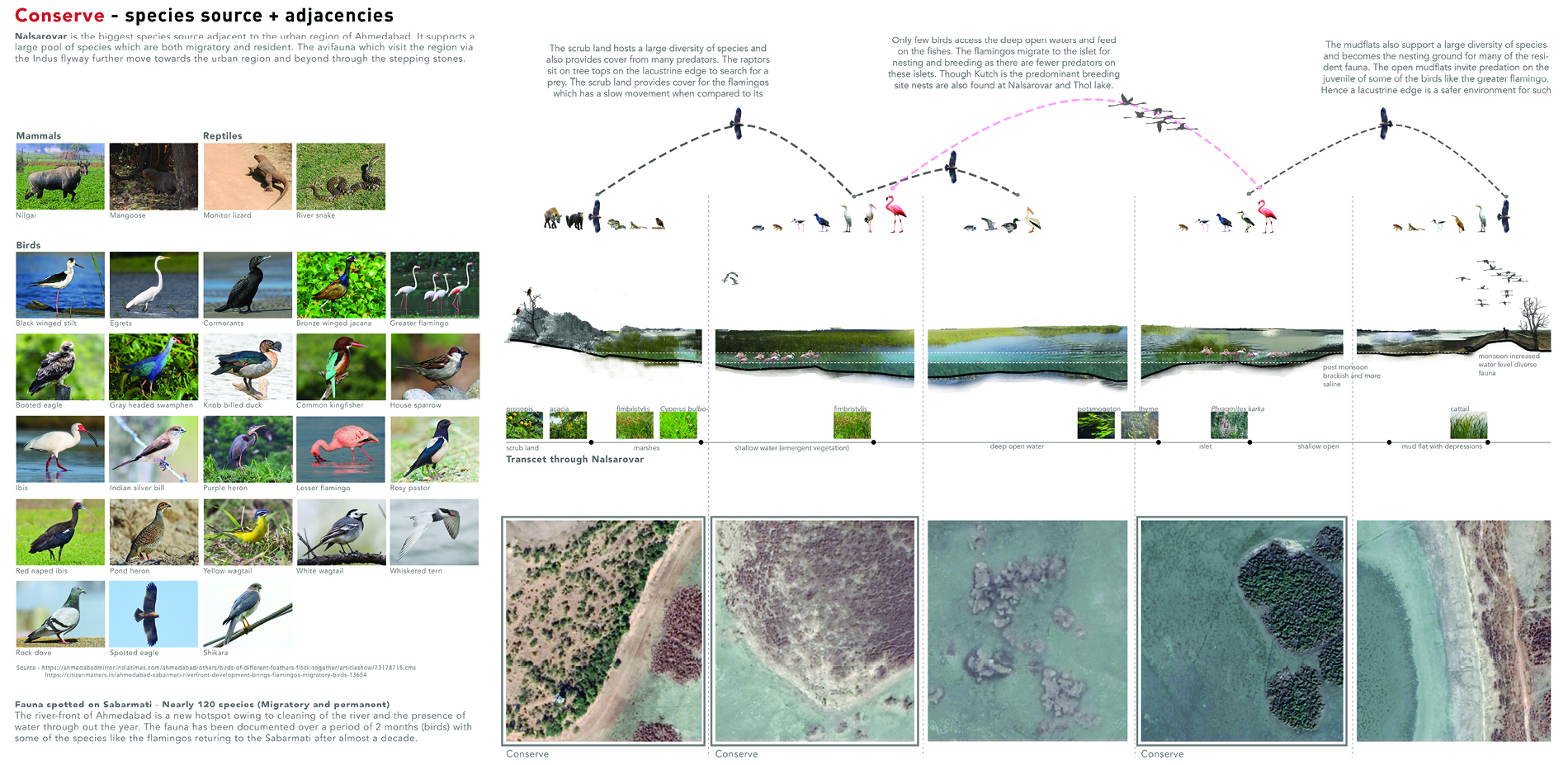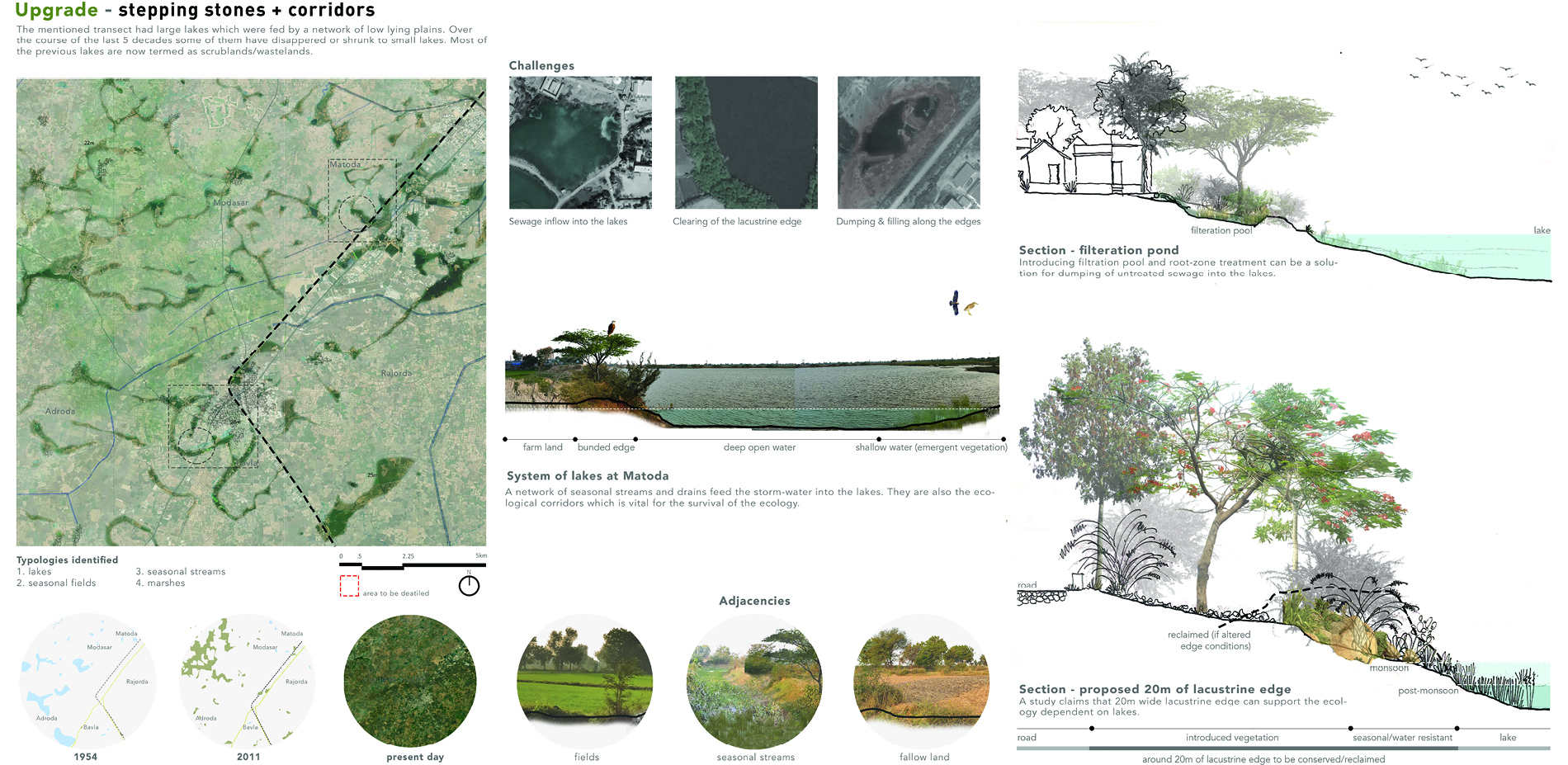Weaving the Unseen - Integrating Urban Wildlife Habitats
Honor Award
Analysis and Planning
Vivin Shankar, Student International ASLA
Faculty Advisors: Anjali Jain; Priyal Shah
Center for Environmental Planning and Technology (CEPT) University
As the city of Ahmedabad, India, continues to grow, its urban wildlife habitats are shrinking; moreover, they are becoming increasingly disconnected from each other, which threatens mobility among the species that inhabit them. Yet Ahmedabad’s surrounding region does boast several oases in the form of rivers and lakes that could be knit together to form a linked network of habitats. By creating stepping stones of hospitable environments between larger reserves, this study proposes implementable interventions that would create corridors to facilitate wildlife movement, while also preserving and restoring pockets of nature within the city.
- 2020 Awards Jury
Project Credits
Faculty advisor
Priyal Shah
Author of Urban ecology
Richard TT Foreman
Author of Cities and natural process
Michael Hough
Project Statement
In the midst of rapid urbanization and climate change, wildlife habitats have become indispensable components of the urban fabric and landscape of cities. Ahmedabad, one of the ten largest cities in India by population, experiences a semi-arid dry climate but has a rich resource of fauna and flora. But, the expanding city tends to fragment the remnant habitats, forested patches, and to transform extensive areas into isolated islands within predominant urban environments. Hence, where they remain isolated and small, the chances of maintaining high wildlife diversity are relatively small. In this scenario, movement of urban fauna has to be considered as an essential need for its survival in the longer run. The project investigates the possibility of an interwoven network of habitats (species sources, stepping stones, urban habitats) which would facilitate movement across the urban region and its adjacencies. It envisions to integrate the remnant urban habitats into a system of linked patches that incorporates the ‘unseen’ components of the Eco-system.
Project Narrative
I. Habitats in an urban context
Urbanization has radically altered both natural habitats and wildlife communities. Farmland, field and woodland species declined drastically as urbanization advanced and suitable habitats were reduced. A few species, however, increased dramatically. While the total number of fauna remained constant, the diversity declined in most urban areas. The urban habitats with the most obvious wildlife potential are the rivers, streams, canals and pre-urban landscapes that still exist within the city’s boundaries.
II. Ahmedabad – patches | mosaic
Ahmedabad is located on the banks of Sabarmati river in the north western state of Gujarat in India. Though Ahmedabad generally experiences a hot, semi-arid climate, with marginally less rainfall it is blessed with diverse flora and fauna. The region includes many species reserves/sources and lies along a major bird migration flyway, the Indus flyway (central Asian flyway). Hence, the urban region is a home to numerous migratory as well as resident birds. The urban region extends up to Gandhinagar on the north, Pariej lake to the south, Khari river to the east and Nalsarovar to west. The region comprises of six major species reserves/sources which sustains diverse fauna across various hotspots within the urban region.
III. Urban fauna – patterns + movement
Ahmedabad is one of the fastest growing Indian cities, and the expanding urban area tends to fragment and disconnect the urban habitats from the rural landscape and from each other. Most of the remnant patches are either small or less diverse to sustain diverse fauna. “At a broad level of planning, the urban environments that have special value for wildlife must be integrated into the spatial networks of the city. This must include not only the recreational parks, but essential natural and human-made connections and the exterior environment as a whole.” – Richard Foreman. The large natural habitats would remain as a source of species that would readily move across to the urban region.
The movement of urban fauna within an urban region becomes vital for its survival although the distance of movement varies from species to species. Movement pattern is broadly between the species source/reserve and the urban area through a series of stepping stones and corridors which provide cover from predators and a place to rest along the journey. Urban wildlife survives, if they can fit their four basic needs (food, water, cover and movement) to the spatial fabric of the urban area and the adjacent context beyond.
IV. Strategical framework
Urban fauna is constantly in movement and dependent on urban region and the rural landscapes to accomplish its fundamental requirements like breeding, nesting, foraging and roosting. These patterns are major determinants of the ecology of the city and the diversity it can sustain. Hence the project would aim to create an urban insert which weaves these unseen components which facilitates movement across the region. It will look at devising frameworks and methods for forging new connections between network of landscapes and the many systems of the city, the people and the urban fauna.
1.Conserve - Species source + adjacencies
2.Upgrade - Stepping stones + corridors
3.Create - Integrated urban habitat
IV. Conserve – Species source + adjacencies
Species reserves/sources are large contiguous natural areas that sustain a large pool of native species that move across to an urban area. Typically, a large natural/semi-natural patch is either within or adjacent to the all built metro area. Nalsarovar is located 60 kilometres to the southwest of the city of Ahmedabad. It is the biggest species reserve/source within the urban region and is a critical destination for migratory birds which travel along the Indus flyway to the Indian subcontinent. Certain patches of landscapes within Nalsarovar are important breeding sites for many resident and migratory birds including the greater flamingos.
1. Investigate the dependencies of the major fauna to the landscape and with each other.
2. Identify critical landscape typologies and regions which are to be conserved for the effective functioning of the ecosystem.
V. Upgrade – stepping stones + corridors
Stepping stones are small green patches used sequentially in movement between the species source and the urban area. Due to fragmentation of remnant natural areas, movement in urban landscapes are primarily dependent on the stepping stones. Stepping stones along with species source and adjacencies are important in determining the broad patterns of movement of urban fauna.
The regions adjacent to Adroda and Bavla, have a cluster of bio-diversity hotspots that function as series of stepping stones between Nalsarovar and the city of Ahmedabad. The sprawling urban area and expanding farm lands have put tremendous pressure on the available resources within the region. The mentioned transect had large lakes which were fed by a network of low lying plains. Over the course of the last 5 decades some of them have disappeared or have shrunk to smaller lakes. The recent land-use map designates some of the previous lakes as scrub-lands and wastelands.
1. Identify the existing typologies of stepping stones and corridors within the region.
2. Analyze the challenges pertaining to the stepping stones and corridors.
3. Investigate the scope and define potential areas to upgrade.
4. Conserve the links and networks within the region.
VI. Create – Integrated urban habitat
Considering the nature of the all built environment, it is necessary to provide an integrated network of patches for effective species movement across an urban area, which combine with large protected natural reserves/sources. This would ensure the diversity of the fauna within the urban habitats and hotspots.
Vasna is located 2 miles to the south of Ahmedabad, the perennial source of water and food from the STP’s coupled with the secluded location makes it a prominent avifauna hotspot within the urban area. The Vasna barrage aids in ponding the upstream water of Sabarmati river as a part of the recently constructed riverfront project of Ahmedabad. Beyond the barrage, Vasna is generally “unseen”, hence exploited and mismanaged.
1. Identify the existing issues pertaining to Vasna.
2. Reintroduce habitat patches wherever necessary.
3. Awareness - Incorporate people as a part of design.
4. Acknowledge the character of the existing landscape and introduce selected species of flora that can sustain a larger species pool of fauna.
VI. Weaving the unseen
The project explores the possibility of creating new links and networks that would weave the larger landscape to the urban environment. “Weaving the unseen”, aims to reinforce movement of urban fauna and integrate real experience of nature in the raw to the inhabitants of Ahmedabad.

